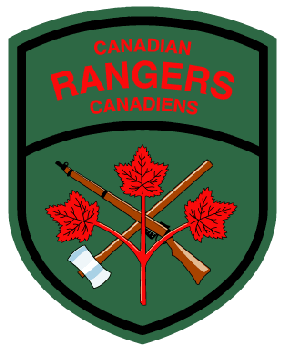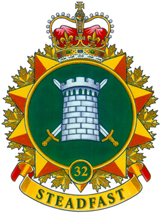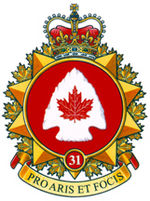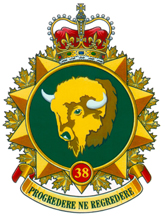
The Canadian Army is the command responsible for the operational readiness of the conventional ground forces of the Canadian Armed Forces. It maintains regular forces units at bases across Canada, and is also responsible for the Army Reserve, the largest component of the Primary Reserve. The Army is headed by the Commander of the Canadian Army and Chief of the Army Staff, who is subordinate to the Chief of the Defence Staff. The Army is also supported by 3,000 civilian employees from the public service.

The 3rd Canadian Division is a formation of the Canadian Army responsible for the command and mobilization of all army units in the provinces of Manitoba, Saskatchewan, Alberta and British Columbia, as well as Northwestern Ontario including the city of Thunder Bay.

The 4th Canadian Division is a formation of the Canadian Army. The division was first created as a formation of the Canadian Corps during the First World War. During the Second World War the division was reactivated as the 4th Canadian Infantry Division in 1941 and then converted to armour and redesignated as the 4th Canadian (Armoured) Division. Beginning in 1916 the division adopted a distinctive green-coloured formation patch as its insignia. In 2013 it was announced that Land Force Central Area would be redesignated 4th Canadian Division. It is currently responsible for Canadian Army operations in the Canadian province of Ontario and is headquartered at Denison Armoury in Toronto.

A Canadian Forces base or CFB is a military installation of the Canadian Armed Forces. For a facility to qualify as a Canadian Forces base, it must station one or more major units.
Canadian Forces Base Calgary, also CFB Calgary, was a Canadian Forces Base located in Calgary, Alberta.

The Canadian Rangers are a sub-component of the Canadian Army under the Canadian Armed Forces reserves that provides a limited military presence in regions of Canada where stationing conventional Army units would not be practical or economically viable. Formally established on May 23, 1947, the Canadian Rangers employs around 5,000 Rangers.

3rd Canadian Division Support Base Edmonton, formerly known as and commonly referred to as CFB Edmonton is a Canadian Forces base located in Sturgeon County adjacent to the City of Edmonton in Alberta, Canada. It is also known as Edmonton Garrison or "Steele Barracks".
41 Combat Engineer Regiment is an Army Reserve (militia) unit of the Canadian Military Engineers/Royal Canadian Engineers (RCE) in Alberta, Canada. The unit consists of:
Beginning with establishment of Fort Calgary in 1875, the city of Calgary, Alberta, has had some degree of permanent military presence throughout its history.
A service battalion is a unit of the Canadian Armed Forces (CAF) that provides combat service support to a brigade group and its elements.

The Primary Reserve of the Canadian Armed Forces is the first and largest of the four sub-components of the Canadian Armed Forces reserves, followed by the Supplementary Reserve, the Cadet Organizations Administration and Training Service and the Canadian Rangers.

41 Canadian Brigade Group is a Canadian Army formation of the 3rd Canadian Division. The formation is composed of Army Reserve units within the province of Alberta and the Northwest Territories. The headquarters of the brigade is in Calgary.

32 Canadian Brigade Group (32CBG) of the Canadian Army is part of the 4th Canadian Division. It is centred on the Greater Toronto Area, as well as Niagara Region and Brantford. It is headquartered at LCol George Taylor Denison III Armoury in Toronto, Ontario.

31 Canadian Brigade Group is part of the 4th Canadian Division, under the Canadian Army. It encompasses the southwestern portion of Ontario, and is headquartered in London, Ontario. The 31 CBG area of responsibility stretches from Hamilton to Windsor. The brigade has approximately 2,400 soldiers. Colonel Chris Brown, CD is Commander of 31 Canadian Brigade Group. The brigade sergeant-major is Chief Warrant Officer Mike Coit, CD.

39 Canadian Brigade Group is a Canadian Forces formation of the Canadian Army under the 3rd Canadian Division. The brigade group is composed of Canadian Forces (CF) Primary Reserve units, all of which are based within the province of British Columbia. 39 CBG Headquarters is at the Major-General B.M. Hoffmeister OC, CB, CBE, DSO Building, 1755 West 1st Avenue, Vancouver.
Area Support Unit Chilliwack is a Canadian Forces facility located in Chilliwack, British Columbia.

38 Canadian Brigade Group is a formation of the Canadian Forces and Canadian Army's 3rd Canadian Division. The brigade group is composed of Primary Reserve units in Manitoba, Saskatchewan and Northwestern Ontario east to Thunder Bay. Geographically, 38 CBG is Canada's largest brigade group. The brigade headquarters is located in Winnipeg, Manitoba.
15 (Edmonton) Field Ambulance is a Canadian Forces Primary Reserve medical unit headquartered in Edmonton, Alberta, with a detachment in Calgary. The unit's mission is to attract, train, force generate and retain high-quality health service personnel to provide health service support to the 41 Canadian Brigade Group and to augment CF's domestic and international operations. An additional and important activity is to participate in activities that will raise its profile in Edmonton and Calgary.

37 Canadian Brigade Group is a reserve component brigade of the Canadian Army, which supervises Militia units in 5th Canadian Division for New Brunswick and Newfoundland and Labrador. It was created by merging the New Brunswick Militia District and the Newfoundland and Labrador Militia District.
The following is a hierarchical outline for the Canadian Armed Forces at the end of the Cold War. It is intended to convey the connections and relationships between units and formations.













